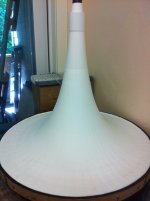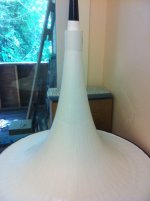carpenter, what did you use and how did you coat the mold??
Hi Bear, are you asking about the material I used to make the mold? I used 90 minute hot mud.
For a release agent, I coated the mold liberally with Vaseline. Use lots at the mid section of the horn and the throat of the horn. These are sticking points because the horn shrinks onto the mold and really grabs it like a vise.
I used 20 minute hot mud to pin the paper strips. You want a fast set, you could even use 5 minute mud if you're skilled. The problem is that the paper is vulnerable when damp, so you have to gently apply the mud in vertical fashion (so not to disturb the paper), then smooth the clumps with a plastic spreader (6" automotive type works well) by turning the lazy susan, as you see me doing in the video clip.
Last edited:
Another thing: that first attempt appears to have separated the inner/outer layers of paper. Make sure your horn is completely dry before pulling it from the mold.
Ooops, missed your post, bqc. Five days should have been sufficient time to dry....
Ooops, missed your post, bqc. Five days should have been sufficient time to dry....
Last edited:
read ur site... why the shellac followed by Urethane car finish? Why not just Urethane car finish, or just shellac, or maybe a polymerized linseed oil varnish??
Also wondering when you rap on the paper horn, what sort of sound do you get?? How about out on the mouth area??
_-_-bear
Also wondering when you rap on the paper horn, what sort of sound do you get?? How about out on the mouth area??
_-_-bear
Wow, you guys exhausted my saliva glands
Did I got it right?: the rim of the horn has plaster mud intermixed into the layers? Because at the end of each layering session you apply a batch of plaster right? Sort of composit material.
Did I got it right?: the rim of the horn has plaster mud intermixed into the layers? Because at the end of each layering session you apply a batch of plaster right? Sort of composit material.
read ur site... why the shellac followed by Urethane car finish? Why not just Urethane car finish, or just shellac, or maybe a polymerized linseed oil varnish??
Also wondering when you rap on the paper horn, what sort of sound do you get?? How about out on the mouth area??
_-_-bear
Shellac is sandable, you need to sand to a sheen before applying urethane.
Rap on horn with knuckles yields a dull bonk sound.
Last edited:
Wow, you guys exhausted my saliva glands
Did I got it right?: the rim of the horn has plaster mud intermixed into the layers? Because at the end of each layering session you apply a batch of plaster right? Sort of composit material.
Correct. After several layers, mud the rim. After the mud sets up (20 minutes) continue applying paper strips over the mud.
the shellac was brush applied?? or sprayed?
the urethane surely was sprayed?
why not just sand and buff the shellac - as in violin finish?
also, there are spot filler automotive primers (sandable) and sandable primers, both are compatible with automotive paints...
any special characteristics of the urethane (nasty stuff to spray) that made you use it over any other coating??
trying to get to the bottom of this step... automotive finishes are tricky stuff...
the urethane surely was sprayed?
why not just sand and buff the shellac - as in violin finish?
also, there are spot filler automotive primers (sandable) and sandable primers, both are compatible with automotive paints...
any special characteristics of the urethane (nasty stuff to spray) that made you use it over any other coating??
trying to get to the bottom of this step... automotive finishes are tricky stuff...
the shellac was brush applied?? or sprayed?
the urethane surely was sprayed?
why not just sand and buff the shellac - as in violin finish?
also, there are spot filler automotive primers (sandable) and sandable primers, both are compatible with automotive paints...
any special characteristics of the urethane (nasty stuff to spray) that made you use it over any other coating??
trying to get to the bottom of this step... automotive finishes are tricky stuff...
Good questions, Bear.
Shellac is rolled on with a foam hot-dog roller, then sanded. Imperfections are spot glazed and sanded, then more shellac. It's useful stuff because it dries fast.
Shellac is not happy when kepted in close proximity to wet paper. Automotive urethane is baked on--tough stuff. I paid $150.00 for one coat plus wet sanding (more than I spent for the entire mold). To keep cost down I did as much finish prep as possible.
Last edited:
Is hot mud the same as warm plaster that is about to set?
Hot mud resembles plaster of Paris with a hardening inhibitor. You can get it in 5, 20, 40, & 90 minute curing times. As a contractor, I use it all the time when remodeling customer's projects.
Here's a horn I'm fabricating for a gentleman in Georgia. Notice the heavy overlapping as the paper extends up the throat of the horn/mold. Also, notice I smoothed out the blisters. The paper strips are 1-5/8" wide and there's only 1/4" reveal showing by the time you reach the top course.
Attachments
After the addition of several more layers, the paper will be flush with the PVC coupler at the throat of the horn. The coupler will eventually be epoxied onto the paper. This serves several purposes: 1. it give a dandy (once holes are drilled into the its top) way to secure a gear puller to remove the horn from the mold. 2. once cut down to 3/4" (vs. the 2-34" presently) it'll fit neatly into the horn perch. The remaining paper should leave a 2" throat for the compression driver. Differences/irregularities can be adjusted with additional layers of paper.
In that close up shot, the glue is wet. Once dry, the paper shrinks and the glue flattens out, The end result is a smooth finish.
here is the outcome of the build and where the horns are usedI will reveal the 6" driver that I plan to use after I have the horn finished and tested. Let's just say that it is a well known full range driver. The prevailing wisdom I have read about suitable drivers are drivers with low Qts (ie strong magnet) this make sense intuitively because at the throat the pressure is higher and you want a driver that has muscle to control the cone. If you use a non compression driver, you want a driver that has a rising response because the highs (beyond 5 K or so ) are not going to be amplified much by the horn. Yes that material is plaster, I got this at home depot in the section where they sell wall join compound , but this is in powder form in 18 lbs bag and it is rated at 90 minutes working time before it hardens. This is what John @inlowsound.com recommends. My only regret so far is not making the turntable motorized or somehow able to turn it with my feet so that both my hands can be free spreading out the plaster quicker.
http://www.diyaudio.com/forums/full-range/237748-avebury-turbo.html
- Status
- Not open for further replies.
- Home
- Loudspeakers
- Full Range
- Started building a 160 hz paper horn for a 6" fullrange


